Abstract
[3H]Phencyclidine binds to synaptic membranes from rat brain in a saturable, reversible, and selective fashion, with a dissociation constant Kd of 0.25 microM and a maximal binding capacity of 2.4 pmol/mg of membrane protein--i.e., 250 pmol/g of brain. The binding activity is concentrated in synaptosomal fractions, is higher in cerebral cortex and corpus striatum than in other parts of the rat brain, and is not detectable in the spinal cord. Only molecules of the phencyclidine series and ketamine are able to bind to the phencyclidine receptor. [3H]Phencyclidine bound to its receptor is not displaced by the classical neurotransmitters or neuromodulators. There is a good correlation between the apparent affinities of a series of phencyclidine analogs for the phencyclidine receptor and the pharacological activities of these analogs as measured by the rotarod assay.
Full text
PDF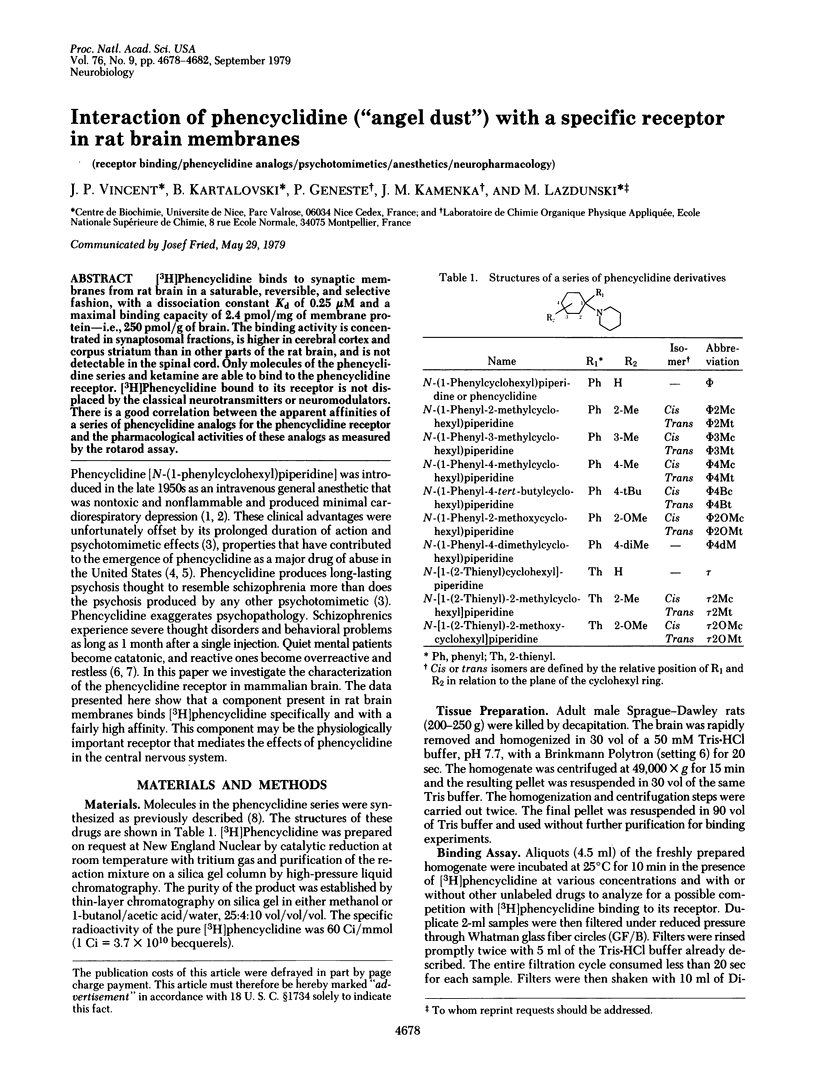
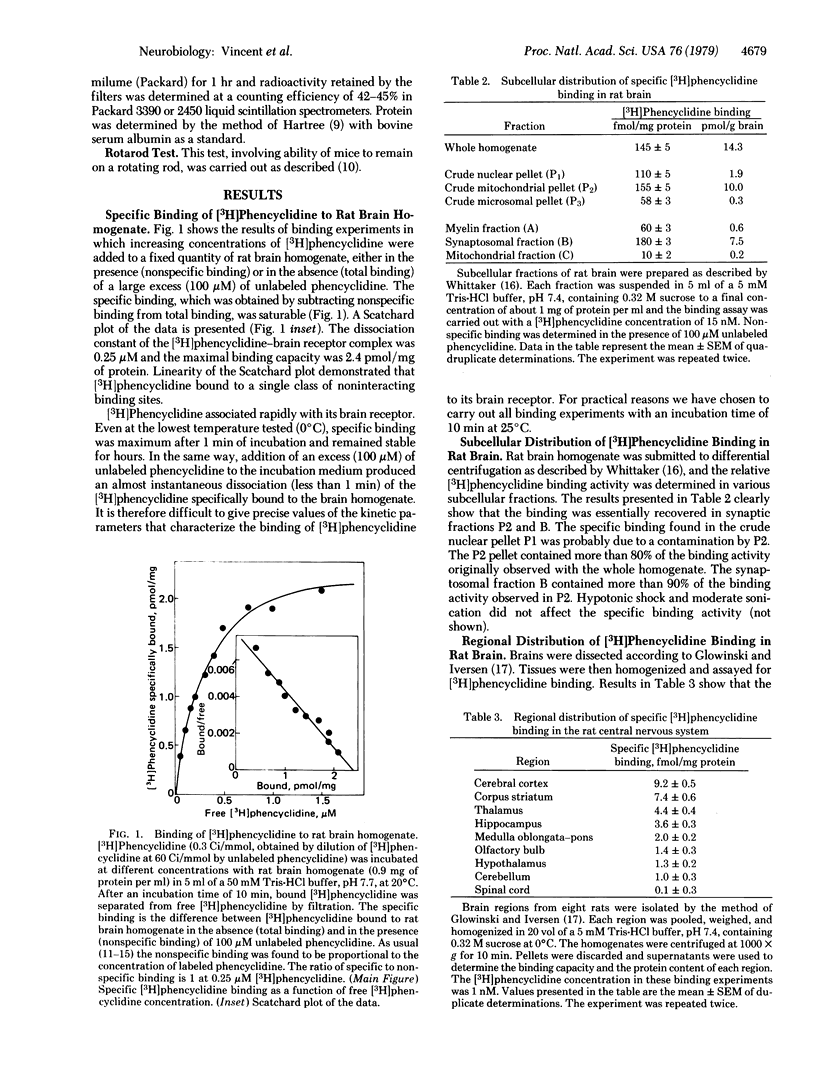
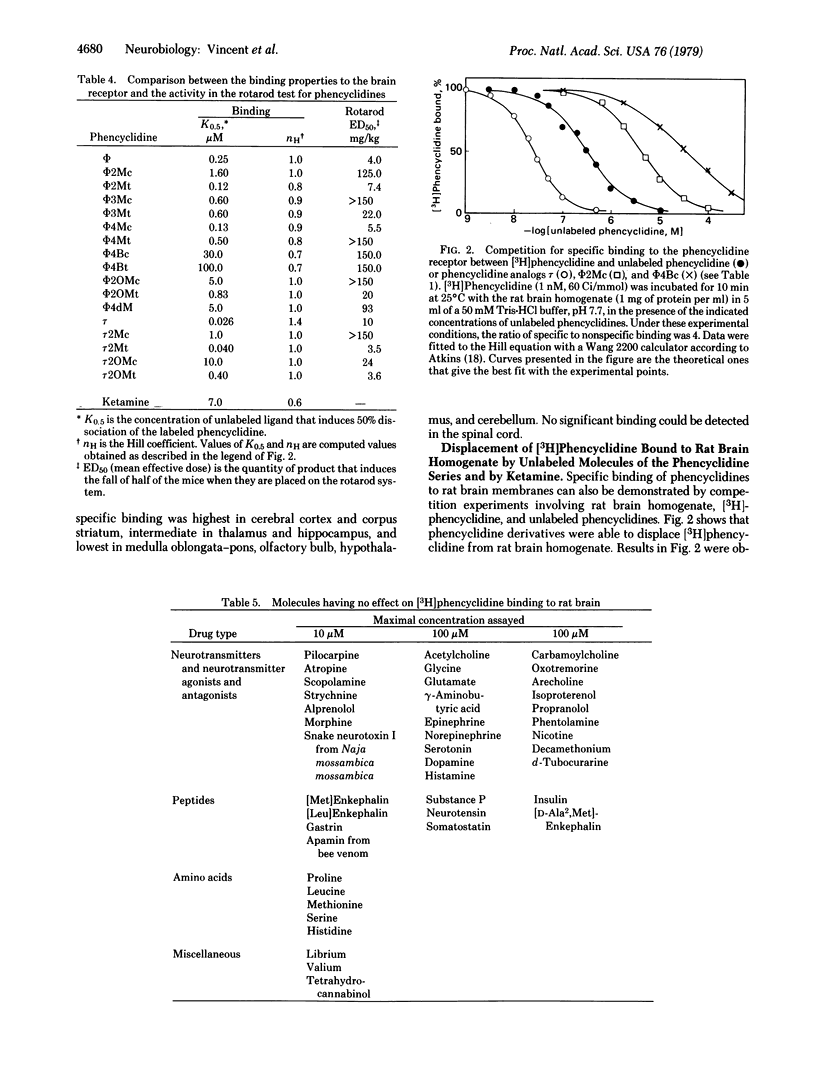
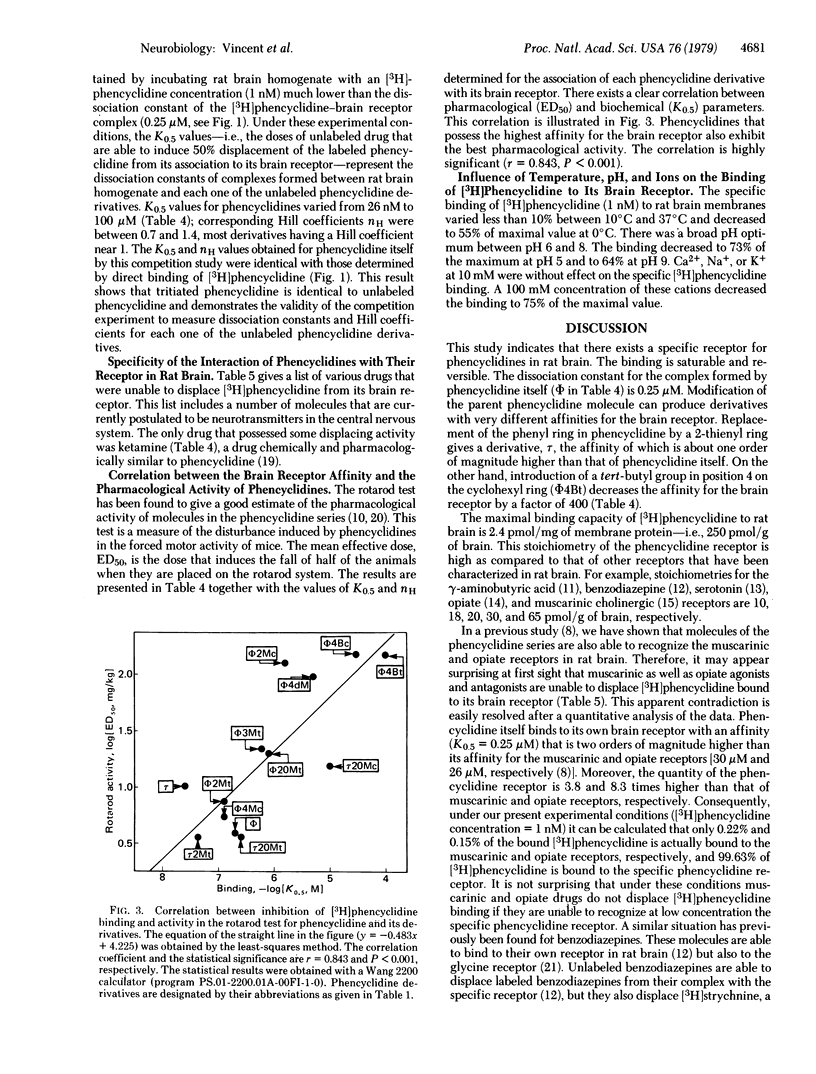
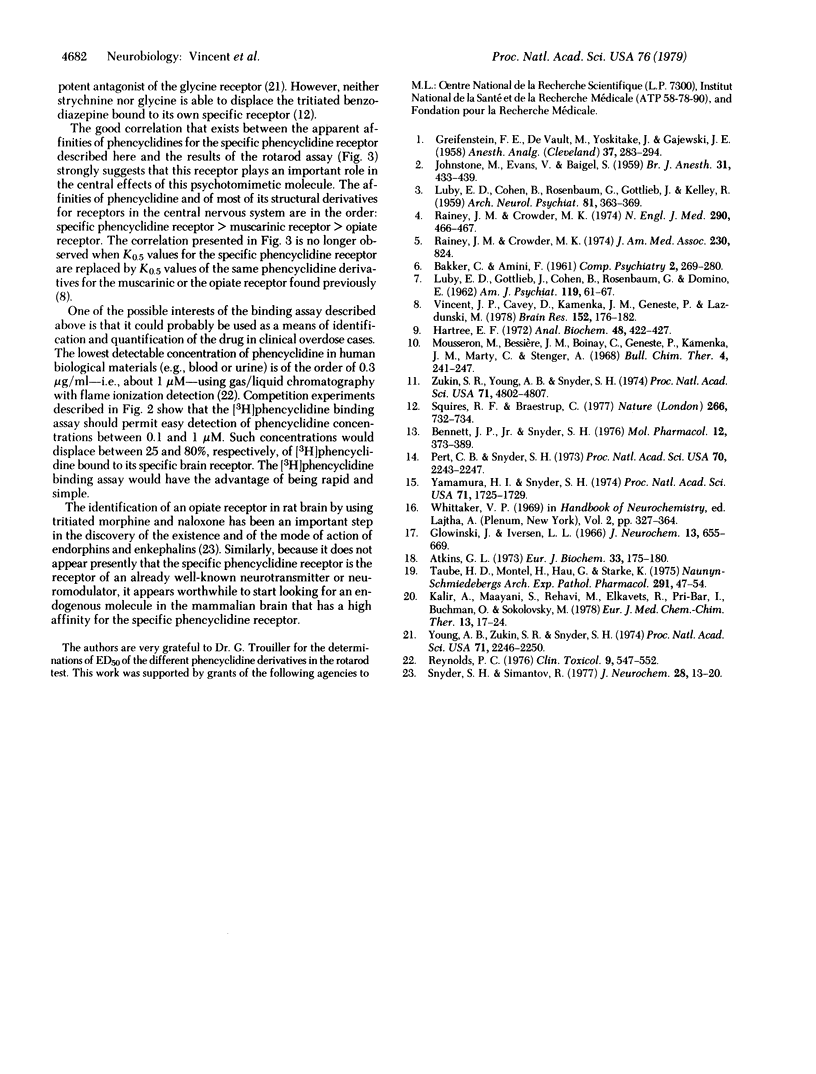
Selected References
These references are in PubMed. This may not be the complete list of references from this article.
- Atkins G. L. A simple digital-computer program for estimating the parameters of the hill equation. Eur J Biochem. 1973 Feb 15;33(1):175–180. doi: 10.1111/j.1432-1033.1973.tb02667.x. [DOI] [PubMed] [Google Scholar]
- BAKKER C. B., AMINI F. B. Observations on the psychotomimetic effects of Sernyl. Compr Psychiatry. 1961 Oct;2:269–280. doi: 10.1016/s0010-440x(61)80033-3. [DOI] [PubMed] [Google Scholar]
- Bennett J. P., Jr, Snyder S. H. Serotonin and lysergic acid diethylamide binding in rat brain membranes: relationship to postsynaptic serotonin receptors. Mol Pharmacol. 1976 May;12(3):373–389. [PubMed] [Google Scholar]
- GREIFENSTEIN F. E., DEVAULT M., YOSHITAKE J., GAJEWSKI J. E. A study of a 1-aryl cyclo hexyl amine for anesthesia. Anesth Analg. 1958 Sep-Oct;37(5):283–294. [PubMed] [Google Scholar]
- Glowinski J., Iversen L. L. Regional studies of catecholamines in the rat brain. I. The disposition of [3H]norepinephrine, [3H]dopamine and [3H]dopa in various regions of the brain. J Neurochem. 1966 Aug;13(8):655–669. doi: 10.1111/j.1471-4159.1966.tb09873.x. [DOI] [PubMed] [Google Scholar]
- Hartree E. F. Determination of protein: a modification of the Lowry method that gives a linear photometric response. Anal Biochem. 1972 Aug;48(2):422–427. doi: 10.1016/0003-2697(72)90094-2. [DOI] [PubMed] [Google Scholar]
- JOHNSTONE M., EVANS V., BAIGEL S. Sernyl (CI-395) in clinical anaesthesia. Br J Anaesth. 1959 Oct;31:433–439. doi: 10.1093/bja/31.10.433. [DOI] [PubMed] [Google Scholar]
- LUBY E. D., COHEN B. D., ROSENBAUM G., GOTTLIEB J. S., KELLEY R. Study of a new schizophrenomimetic drug; sernyl. AMA Arch Neurol Psychiatry. 1959 Mar;81(3):363–369. doi: 10.1001/archneurpsyc.1959.02340150095011. [DOI] [PubMed] [Google Scholar]
- Pert C. B., Snyder S. H. Properties of opiate-receptor binding in rat brain. Proc Natl Acad Sci U S A. 1973 Aug;70(8):2243–2247. doi: 10.1073/pnas.70.8.2243. [DOI] [PMC free article] [PubMed] [Google Scholar]
- Rainey J. M., Jr, Crowder M. K. Letter: Ketamine or phencyclidine. JAMA. 1974 Nov 11;230(6):824–824. [PubMed] [Google Scholar]
- Rainey J. M., Jr, Crowder M. K. Letter: Prevalence of phencyclidine in street drug preparations. N Engl J Med. 1974 Feb 21;290(8):466–467. doi: 10.1056/nejm197402212900826. [DOI] [PubMed] [Google Scholar]
- Reynolds P. C. Clinical and forensic experiences with phencyclidine. Clin Toxicol. 1976;9(4):547–552. doi: 10.3109/15563657608988156. [DOI] [PubMed] [Google Scholar]
- Snyder S. H., Simantov R. The opiate receptor and opoid peptides. J Neurochem. 1977 Jan;28(1):13–20. doi: 10.1111/j.1471-4159.1977.tb07703.x. [DOI] [PubMed] [Google Scholar]
- Squires R. F., Brastrup C. Benzodiazepine receptors in rat brain. Nature. 1977 Apr 21;266(5604):732–734. doi: 10.1038/266732a0. [DOI] [PubMed] [Google Scholar]
- Taube H. D., Montel H., Hau G., Starke K. Phencyclidine and ketamine: comparison with the effect of cocaine on the noradrenergic neurones of the rat brain cortex. Naunyn Schmiedebergs Arch Pharmacol. 1975;291(1):47–54. doi: 10.1007/BF00510820. [DOI] [PubMed] [Google Scholar]
- Vincent J. P., Cavey D., Kamenka J. M., Geneste P., Lazdunski M. Interaction of phencyclidines with the muscarinic and opiate receptors in the central nervous system. Brain Res. 1978 Aug 18;152(1):176–182. doi: 10.1016/0006-8993(78)90145-2. [DOI] [PubMed] [Google Scholar]
- Yamamura H. I., Snyder S. H. Muscarinic cholinergic binding in rat brain. Proc Natl Acad Sci U S A. 1974 May;71(5):1725–1729. doi: 10.1073/pnas.71.5.1725. [DOI] [PMC free article] [PubMed] [Google Scholar]
- Young A. B., Zukin S. R., Snyder S. H. Interaction of benzodiazepines with central nervous glycine receptors: possible mechanism of action. Proc Natl Acad Sci U S A. 1974 Jun;71(6):2246–2250. doi: 10.1073/pnas.71.6.2246. [DOI] [PMC free article] [PubMed] [Google Scholar]
- Zukin S. R., Young A. B., Snyder S. H. Gamma-aminobutyric acid binding to receptor sites in the rat central nervous system. Proc Natl Acad Sci U S A. 1974 Dec;71(12):4802–4807. doi: 10.1073/pnas.71.12.4802. [DOI] [PMC free article] [PubMed] [Google Scholar]


